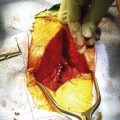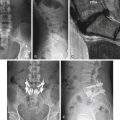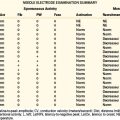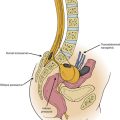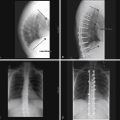Chapter 14 Definition and Assessment of Dysfunctional Segmental Motion
Biomechanics of a Dysfunctional Motion Segment
Biomechanical evaluation of the FSU is achieved mainly through cadaveric specimen studies. Much of the body of knowledge regarding spinal biomechanics is based on in vitro assessment of specimens obtained from fresh-frozen cadavers. Specimens, stripped of musculature, are loaded to predetermined bending load levels to quantify the biomechanical response of the FSU. Although limited, the in vitro analysis of FSU motion can be highly controlled and detailed. Numerous researchers studying in vitro FSU biomechanics have shown that the response of the FSU to external loading is associated with two characteristic flexibility zones: the neutral zone (NZ) and the elastic zone (EZ). The NZ is a segment of the flexibility curve within which small loads can generate large displacements. The EZ is a segment within which lesser displacements result from greater load application—without causing mechanical injury to the spine. The sum of the two zones (neutral plus elastic zones) comprises the total range of motion (ROM) of the spine under physiologic loading conditions.
It has been suggested that the width of the NZ is the best indicator of spinal instability (due either to injury or degeneration).1–5 Panjabi et al. studied the influence of traumatic ligamentous injury on the stability of the thoracolumbar spine.6 They demonstrated that both ROM and the NZ increased after destabilizing trauma. However, the NZ was observed to be a more sensitive indicator of instability.
Mimura et al. studied multidirectional flexibility of FSUs with a variety of degeneration grades.7 They observed that the ROM decreased in the sagittal and lateral planes and increased in axial rotation. In addition, they noted an increase in the laxity at the joint, which was associated with the instability index (the ratio of the NZ to the ROM; i.e., the NZ ratio).
Tanaka et al. investigated the effect of degeneration on the flexibility of 114 FSUs obtained from 47 cadaveric lumbar spines.8 They categorized specimens in five degeneration grades based on radiographic (MRI) and cryomicrotome section analyses. All specimens were tested biomechanically for flexion, extension, lateral bending, and axial rotation. Rotations and translations were recorded. Both techniques seemed to be in an agreement regarding the advanced stages of degeneration, more so than for early stages. The investigators did not report any data regarding the NZ, but did demonstrate that the upper lumbar FSUs were associated with a significantly increased ROM (in rotations and translations) during sagittal bending and axial rotation as the degeneration progressed toward grade IV. ROM decreased at the grade V level. For the lower lumbar FSUs, ROM increased up to the grade III level of degeneration, followed by a decrease at grades IV and V. This observation was statistically significant only during axial rotation and lateral bending.
Schmidt et al. investigated the stiffness of cadaveric lumbar motion segments with radial tears in discs detected by MRI and cryomicrotome sections under sagittal, lateral, and axial rotations.9 They used normal control specimens (n = 4) and degenerated specimens (n = 16) with radial tears in the anulus. Specimens with radial tears exhibited loss of stiffness at varying degrees in all planes of motion.
Zhao et al. studied the effect of the depressurized nucleus fibrosus with end plate disruption on FSU motion characteristics.10 Twenty-one thoracolumbar motion segments, of which four were normal, were studied. Sixteen specimens had pre-existing moderate degeneration, and one had pre-existing severe degeneration. All specimens were tested for bending motion using an eccentric (i.e., off-axis) axial loading mechanism. The investigators loaded the specimen in creep (i.e., prolonged exposure to a constant load) to remove the water content from the nucleus and then loaded the specimen in compression-to-failure to generate end plate disruption, which simulated advanced degeneration. They monitored their procedures by pressure measurements within the disc. The comparison of the flexibility tests before and after the degeneration-inducing maneuvers demonstrated that there were substantial increases in NZ and ROM as well as the instability index (NZ/ROM) in flexion and lateral bending.
Fujiwara et al. studied the effects of disc degeneration and facet joint osteoarthritis on the segmental flexibility of the lumbar spine.11 They graded the degeneration (grades I to V) of 110 lumbar motion segments obtained from 19 female and 25 male cadavers using MRI films and biomechanical tests. They observed an increase in ROM in axial rotation, flexion, and extension as the degeneration advanced (grades II to IV), followed by a decrease at degeneration grade V. In lateral bending, ROM increased at grade III and decreased in more advanced levels. This observation was true for both sexes.
Gay et al. studied the effect of degeneration on spinal flexibility during stepwise loading and continuous loading conditions in an in vitro evaluation.12 The NZ and ROM have been observed to be larger with stepwise loading compared with continuous loading.13 The effect of degeneration on spinal flexibility had not previously been studied for both assessment techniques in the same experimental model. Gay et al. demonstrated that the NZ and ROM, assessed using both stepwise and continuous loading techniques, showed a trend similar to that observed with macroscopic evaluation of disc degeneration. In other words, spinal flexibility increased with degeneration up to grade III and decreased at grade IV.
Oxland et al. investigated the relationship between bone density, disc degeneration, and flexibility in cadaveric spinal specimens.14 They demonstrated a significant increase in ROM in axial rotation, as well as a significant decrease in the NZ in lateral bending, as the degeneration grade increased. There were no significant changes observed in ROM and NZ associated with degeneration level during sagittal motion. In this study, the investigators used axial loading during bending testing to simulate muscle forces, which may have influenced the alterations of the NZ.
In Vivo Assessment of Three-Dimensional Functional Spinal Unit Kinematics
External markers that are percutaneously attached to the pedicles or spinous processes have been used to assess spinal motion in vivo. Rozumalski et al. analyzed the motion of the lumbar spine during walking with markers attached to the spinous processes of 10 healthy subjects.15 They reported intervertebral rotations in all planes during walking. Dickey et al. investigated the correlation of pain and vertebral motion in patients with chronic low back pain using external fixators attached to the pedicles.16 Although these techniques have produced invaluable data, they have not gained wide acceptance because of patient-associated risks and pain.
MRI provides a noninvasive technology for researchers to analyze in vivo spinal kinematics. Fujii et al. measured intervertebral motion in the lumbar spine in 10 healthy subjects. They applied passive trunk rotations using a rotation device tightly strapped to the pelvis, while the shoulders were fixed.17 They measured lumbar 3D kinematics from neutral to maximum position with 15-degree passive pelvic axial rotation increments. Each step required a 5-minute imaging time. The researchers successfully measured the intervertebral rotations and translations in all planes. The main shortcoming of the study was the fact that the fixed axis of rotation of the device was not designed to be coaxial with that of the subject’s spine. This could result in non-natural rotation.
A dual-fluoroscopy approach has also been used to quantify the 3D kinematics of the human spine. Although this technique is associated with radiation exposure to the subject, it is otherwise noninvasive and allows unrestricted normal motion of the trunk. Li et al. studied the intervertebral motion of the lumbar spine in all planes in 11 asymptomatic subjects.18 3D reconstructed images of subjects in neutral posture were registered with images obtained with using dual fluoroscopy during sagittal, axial, and lateral motions. They reported rotations and translations in all planes.
Ahmadi et al. analyzed the kinematics of lumbar motion in patients with lumbar segmental instability using video-assisted fluoroscopy.19 They compared 15 matched healthy subjects with patients with chronic low back pain who were diagnosed with lumbar instability according to the clinical test of Hicks et al.20 The authors reported significant differences in intersegmental sagittal translations at the L5-S1 level. They also showed that the instant axis of rotation moved in a larger area for patients with low back pain compared with healthy control subjects at both the L1-2 and L5-S1 levels.
Passias et al. recently compared in vivo lumbar segmental motion between patients with low back pain and healthy control subjects.21 All patients with low back pain had pathology at the L4-5 and L5-S1 discs, which was confirmed clinically and radiographically. Significant differences were observed between the degenerative and control group ROMs at the L3-4 disc in lateral bending and axial rotation, and at the L4-5 disc in flexion.
Fujiwara A., Lim T.H., An H.S., et al. The effect of disc degeneration and facet joint osteoarthritis on the segmental flexibility of the lumbar spine. Spine (Phila Pa 1976). 2000;25:3036-3044.
Mimura M., Panjabi M.M., Oxland T.R., et al. Disc degeneration affects the multidirectional flexibility of the lumbar spine. Spine (Phila Pa 1976). 1994;19:1371-1380.
Oxland T.R., Lund T., Jost B., et al. The relative importance of vertebral bone density and disc degeneration in spinal flexibility and interbody implant performance: an in vitro study. Spine (Phila Pa 1976). 1996;21:2558-2569.
Panjabi M.M. The stabilizing system of the spine: Part II. Neutral zone and instability hypothesis. J Spinal Disord. 1992;5:390-396.
Tanaka N., An H.S., Lim T.H., et al. The relationship between disc degeneration and flexibility of the lumbar spine. Spine J. 2001;1:47-56.
Yue J.J., Timm J.P., Panjabi M.M., et al. Clinical application of the Panjabi neutral zone hypothesis: the Stabilimax NZ posterior lumbar dynamic stabilization system. Neurosurg Focus. 2007;22:E12.
1. Kifune M., Panjabi M.M., Arand M., et al. Fracture pattern and instability of thoracolumbar injuries. Eur Spine J. 1995;4:98-103.
2. Panjabi M.M. The stabilizing system of the spine: Part II. Neutral zone and instability hypothesis. J Spinal Disord. 1992;5:390-396.
3. Panjabi M.M. Clinical spinal instability and low back pain. J Electromyogr Kinesiol. 2003;13:371-379.
4. Panjabi M.M., Lydon C., Vasavada A., et al. On the understanding of clinical instability. Spine (Phila Pa 1976). 1994;19:2642-2650.
5. Yue J.J., Timm J.P., Panjabi M.M., et al. Clinical application of the Panjabi neutral zone hypothesis: the Stabilimax NZ posterior lumbar dynamic stabilization system. Neurosurg Focus. 2007;22:E12.
6. Panjabi M.M., Oxland T.R., Lin R.M., et al. Thoracolumbar burst fracture: a biomechanical investigation of its multidirectional flexibility. Spine (Phila Pa 1976). 1994;19:578-585.
7. Mimura M., Panjabi M.M., Oxland T.R., et al. Disc degeneration affects the multidirectional flexibility of the lumbar spine. Spine (Phila Pa 1976). 1994;19:1371-1380.
8. Tanaka N., An H.S., Lim T.H., et al. The relationship between disc degeneration and flexibility of the lumbar spine. Spine J. 2001;1:47-56.
9. Schmidt T.A., An H.S., Lim T.H., et al. The stiffness of lumbar spinal motion segments with a high-intensity zone in the anulus fibrosus. Spine (Phila Pa 1976). 1998;23:2167-2173.
10. Zhao F., Pollintine P., Hole B.D., et al. Discogenic origins of spinal instability. Spine (Phila Pa 1976). 2005;30:2621-2630.
11. Fujiwara A., Lim T.H., An H.S., et al. The effect of disc degeneration and facet joint osteoarthritis on the segmental flexibility of the lumbar spine. Spine (Phila Pa 1976). 2000;25:3036-3044.
12. Gay R.E., Ilharreborde B., Zhao K., et al. Sagittal plane motion in the human lumbar spine: comparison of the in vitro quasistatic neutral zone and dynamic motion parameters. Clin Biomech (Bristol, Avon). 2006;21(9):914-919.
13. Goertzen D.J., Lane C., Oxland T.R. Neutral zone and range of motion in the spine are greater with stepwise loading than with a continuous loading protocol: an in vitro porcine investigation. J Biomech. 2004;37:257-261.
14. Oxland T.R., Lund T., Jost B., et al. The relative importance of vertebral bone density and disc degeneration in spinal flexibility and interbody implant performance: an in vitro study. Spine (Phila Pa 1976). 1996;21:2558-2569.
15. Rozumalski A., Schwartz M.H., Wervey R., et al. The in vivo three-dimensional motion of the human lumbar spine during gait. Gait Posture. 2008;28:378-384.
16. Dickey J.P., Pierrynowski M.R., Bednar D.A., et al. Relationship between pain and vertebral motion in chronic low-back pain subjects. Clin Biomech (Bristol, Avon). 2002;17:345-352.
17. Fujii R., Sakaura H., Mukai Y., et al. Kinematics of the lumbar spine in trunk rotation: in vivo three-dimensional analysis using magnetic resonance imaging. Eur Spine J. 2007;16:1867-1874.
18. Li G., Wang S., Passias P., et al. Segmental in vivo vertebral motion during functional human lumbar spine activities. Eur Spine J. 2009;18:1013-1021.
19. Ahmadi A., Maroufi N., Behtash H., et al. Kinematic analysis of dynamic lumbar motion in patients with lumbar segmental instability using digital videofluoroscopy. Eur Spine J. 2009;18:1677-1685.
20. Hicks G.E., Fritz J.M., Delitto A., et al. Preliminary development of a clinical prediction rule for determining which patients with low back pain will respond to a stabilization exercise program. Arch Phys Med Rehabil. 2005;86:1753-1762.
21. Passias P.G., Wang S., Kozanek M., et al. Segmental lumbar rotation in patients with discogenic low back pain during functional weight-bearing activities. J Bone Joint Surg [Am]. 2011;93:29-37.


